 W
WAn air-gap flash is a photographic light source capable of producing sub-microsecond light flashes, allowing for (ultra) high-speed photography. This is achieved by a high-voltage electric discharge between two electrodes over the surface of a quartz tube. The distance between the electrodes is such that a spontaneous discharge does not occur. To start the discharge a high-voltage pulse is applied on an electrode inside the quartz tube.
 W
WAirglow is a faint emission of light by a planetary atmosphere. In the case of Earth's atmosphere, this optical phenomenon causes the night sky never to be completely dark, even after the effects of starlight and diffused sunlight from the far side are removed.
 W
WAn aurora, sometimes referred to as polar lights, northern lights, or southern lights, is a natural light display in the Earth's sky, predominantly seen in high-latitude regions.
 W
WA backlight is a form of illumination used in liquid crystal displays (LCDs). As LCDs do not produce light by themselves—unlike, for example, cathode ray tube (CRT) displays—they need illumination to produce a visible image. Backlights illuminate the LCD from the side or back of the display panel, unlike frontlights, which are placed in front of the LCD. Backlights are used in small displays to increase readability in low light conditions such as in wristwatches, and are used in smart phones, computer displays and LCD televisions to produce light in a manner similar to a CRT display. A review of some early backlighting schemes for LCDs is given in a report Engineering and Technology History by Peter J. Wild.
 W
WBioluminescence is the production and emission of light by a living organism. It is a form of chemiluminescence. Bioluminescence occurs widely in marine vertebrates and invertebrates, as well as in some fungi, microorganisms including some bioluminescent bacteria, and terrestrial arthropods such as fireflies. In some animals, the light is bacteriogenic, produced by symbiotic bacteria such as those from the genus Vibrio; in others, it is autogenic, produced by the animals themselves.
 W
WA campfire is a fire at a campsite that provides light and warmth, and heat for cooking. It can also serve as a beacon, and an insect and predator deterrent. Established campgrounds often provide a stone or steel fire ring for safety. Campfires are a popular feature of camping. At summer camps, the word campfire often refers to an event at which there is a fire. Some camps refer to the fire itself as a campfire.
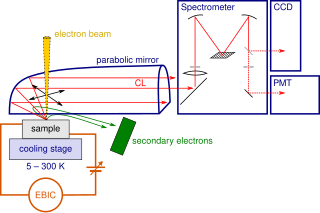 W
WCathodoluminescence is an optical and electromagnetic phenomenon in which electrons impacting on a luminescent material such as a phosphor, cause the emission of photons which may have wavelengths in the visible spectrum. A familiar example is the generation of light by an electron beam scanning the phosphor-coated inner surface of the screen of a television that uses a cathode ray tube. Cathodoluminescence is the inverse of the photoelectric effect, in which electron emission is induced by irradiation with photons.
 W
WThe ceremonial use of lights occurs in liturgies of various Christian Churches, as well as in Jewish, Zoroastrian and Hindu rites and customs.
 W
WCherenkov radiation is electromagnetic radiation emitted when a charged particle passes through a dielectric medium at a speed greater than the phase velocity of light in that medium. Special relativity is not violated since light travels slower in materials with refractive index greater than one, and it is the speed of light in a vacuum which cannot be reached by particles with mass. A classic example of Cherenkov radiation is the characteristic blue glow of an underwater nuclear reactor. Its cause is similar to the cause of a sonic boom, the sharp sound heard when faster-than-sound movement occurs. The phenomenon is named for Soviet physicist Pavel Cherenkov, who shared the 1958 Nobel Prize in Physics for its discovery.
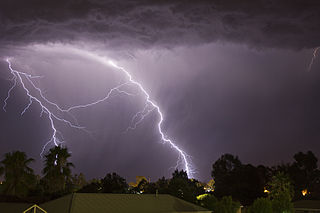 W
WA dry thunderstorm is a thunderstorm that produces thunder and lightning, but most or all of its precipitation evaporates before reaching the ground. Dry lightning refers to lightning strikes occurring in this situation. Both are so common in the American West that they are sometimes used interchangeably. The latter term is a technical misnomer since lightning itself is neither wet nor dry.
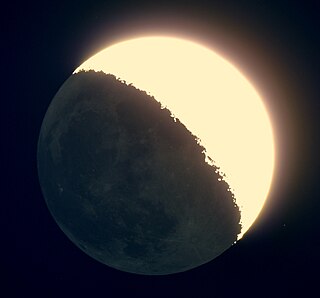 W
WEarthlight is the diffuse reflection of sunlight reflected from Earth's surface and clouds. Earthshine, also known as the Moon's ashen glow, is the dim illumination of the otherwise unilluminated portion of the Moon by this indirect sunlight. Earthlight on the Moon during the waxing crescent is called "the old Moon in the new Moon's arms", while that during the waning crescent is called "the new Moon in the old Moon's arms".
 W
WElectroluminescence (EL) is an optical phenomenon and electrical phenomenon in which a material emits light in response to the passage of an electric current or to a strong electric field. This is distinct from black body light emission resulting from heat (incandescence), a chemical reaction (chemiluminescence), sound (sonoluminescence), or other mechanical action (mechanoluminescence).
 W
WAn ethanol fireplace, is a type of fireplace which burns ethanol fuel. They are often installed without a chimney. Ethanol for these fires is often marketed as bioethanol.
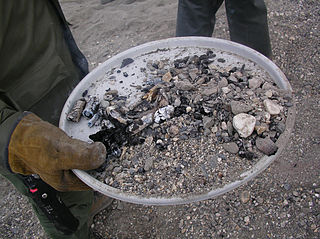 W
WA fire pan is a pan for holding or conveying fire which is often used as method for building a Leave No Trace fire.
 W
WFireworks are a class of low explosive pyrotechnic devices used for aesthetic and entertainment purposes. The most common use of a firework is as part of a fireworks display, a display of the effects produced by firework devices.
 W
WA flamethrower is a ranged incendiary device designed to project a controllable jet of fire. First deployed by the Byzantine Greeks in the 1st century AD, flamethrowers saw use in modern times during World War I, and more widely in World War II as a tactical siege weapon against fortifications.
 W
WA flash is a device used in photography producing a flash of artificial light at a color temperature of about 5500 K to help illuminate a scene. A major purpose of a flash is to illuminate a dark scene. Other uses are capturing quickly moving objects or changing the quality of light. Flash refers either to the flash of light itself or to the electronic flash unit discharging the light. Most current flash units are electronic, having evolved from single-use flashbulbs and flammable powders. Modern cameras often activate flash units automatically.
 W
WA formation light is a type of thin film electroluminescent light that assists aircraft flying in formation in low visibility environments.
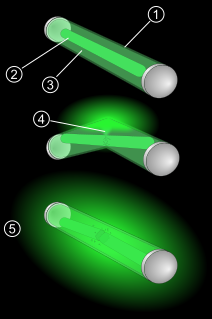 W
WA glow stick is a self-contained, short-term light-source. It consists of a translucent plastic tube containing isolated substances that, when combined, make light through chemiluminescence, so it does not require an external energy source. The light cannot be turned off and can be used only once. Glow sticks are often used for recreation, but may also be relied upon for light during military, police, fire, or emergency medical services operations. They are also used by military and police to mark "clear" areas.
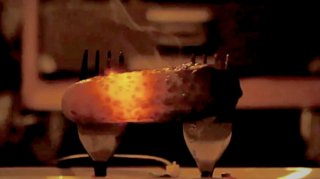 W
WApplying line voltage across a pickled cucumber causes it to glow. A moist pickle contains salt as a result of the pickling process, which allows it to conduct electricity. Sodium ions within the pickle emit light as a result of atomic electron transitions, although it is not clear why the luminescence occurs at one end of the pickle.
 W
WA great comet is a comet that becomes exceptionally bright. There is no official definition; often the term is attached to comets such as Halley's Comet, which during certain appearances are bright enough to be noticed by casual observers who are not looking for them, and become well known outside the astronomical community. Great comets are rare; on average, only one will appear in a decade. Although comets are officially named after their discoverers, great comets are sometimes also referred to by the year in which they appeared great, using the formulation "The Great Comet of ...", followed by the year.
 W
WWhen setting photoflash exposures, the guide number (GN) of photoflash devices is a measure photographers can use to calculate either the required f‑stop for any given flash-to-subject distance, or the required distance for any given f‑stop. To solve for either of these two variables, one merely divides a device's guide number by the other.
 W
WIncandescence is the emission of electromagnetic radiation from a hot body as a result of its high temperature. The term derives from the Latin verb incandescere, to glow white.
 W
WA light pillar is an atmospheric optical phenomenon in which a vertical beam of light appears to extend above and/or below a light source. The effect is created by the reflection of light from tiny ice crystals that are suspended in the atmosphere or that comprise high-altitude clouds. If the light comes from the Sun, the phenomenon is called a sun pillar or solar pillar. Light pillars can also be caused by the Moon or terrestrial sources, such as streetlights.
 W
WLight pollution is the presence of anthropogenic and artificial light in the night environment. It is exacerbated by excessive, misdirected or obtrusive use of light, but even carefully used light fundamentally alters natural conditions. As a major side-effect of urbanization, it is blamed for compromising health, disrupting ecosystems and spoiling aesthetic environments.
 W
WLuminescence is spontaneous emission of light by a substance not resulting from heat; or "cold light".
 W
WA meteorite fall, also called an observed fall, is a meteorite collected after its fall from outer space was observed by people or automated devices. Any other meteorite is called a "find". There are more than 1,100 documented falls listed in widely used databases, most of which have specimens in modern collections. As of January 2019, the Meteoritical Bulletin Database had 1,180 confirmed falls.
 W
WMoonlight consists of mostly sunlight reflected from the parts of the Moon's surface where the Sun's light strikes.
 W
WMuzzle flash is the light — both visible and infrared — created by a muzzle blast, which is caused by the sudden release and expansion of high-temperature, high-pressure gases from the muzzle of a firearm during shooting. Both the blast and flash are products of the exothermic combustion of the propellant (gunpowder), and any remaining unburned powders reacting with ambient air. The size and shape of the muzzle flash is dependent on the combustion energy of propellant being used, the amount of combustible ejecta remaining, and any devices attached to the muzzle.
 W
WThe photosphere is a star's outer shell from which light is radiated.
 W
WPlanetshine is the dim illumination, by sunlight reflected from a planet, of all or part of the otherwise dark side of any moon orbiting the body. Planetlight is the diffuse reflection of sunlight from a planet, whose albedo can be measured.
 W
WSkyglow is the diffuse luminance of the night sky, apart from discrete light sources such as the Moon and visible individual stars. It is a commonly noticed aspect of light pollution. While usually referring to luminance arising from artificial lighting, skyglow may also involve any scattered light seen at night, including natural ones like starlight, zodiacal light, and airglow.
 W
WThe solar transition region is a region of the Sun's atmosphere, between the chromosphere and corona. It is visible from space using telescopes that can sense ultraviolet. It is important because it is the site of several unrelated but important transitions in the physics of the solar atmosphere:Below, gravity tends to dominate the shape of most features, so that the Sun may often be described in terms of layers and horizontal features ; above, dynamic forces dominate the shape of most features, so that the transition region itself is not a well-defined layer at a particular altitude. Below, most of the helium is not fully ionized, so that it radiates energy very effectively; above, it becomes fully ionized. This has a profound effect on the equilibrium temperature. Below, the material is opaque to the particular colors associated with spectral lines, so that most spectral lines formed below the transition region are absorption lines in infrared, visible light, and near ultraviolet, while most lines formed at or above the transition region are emission lines in the far ultraviolet (FUV) and X-rays. This makes radiative transfer of energy within the transition region very complicated. Below, gas pressure and fluid dynamics usually dominate the motion and shape of structures; above, magnetic forces dominate the motion and shape of structures, giving rise to different simplifications of magnetohydrodynamics. The transition region itself is not well studied in part because of the computational cost, uniqueness, and complexity of Navier–Stokes combined with electrodynamics.
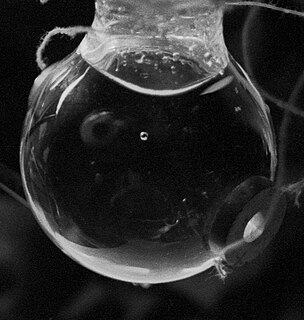 W
WSonoluminescence is the emission of short bursts of light from imploding bubbles in a liquid when excited by sound.
 W
WSt. Elmo's fire is a weather phenomenon in which luminous plasma is created by a corona discharge from a sharp or pointed object in a strong electric field in the atmosphere.
 W
WA star is an astronomical object consisting of a luminous spheroid of plasma held together by its own gravity. The nearest star to Earth is the Sun. Many other stars are visible to the naked eye from Earth during the night, appearing as a multitude of fixed luminous points in the sky due to their immense distance from Earth. Historically, the most prominent stars were grouped into constellations and asterisms, the brightest of which gained proper names. Astronomers have assembled star catalogues that identify the known stars and provide standardized stellar designations. The observable Universe contains an estimated 1×1024 stars, but most are invisible to the naked eye from Earth, including all stars outside our galaxy, the Milky Way.
 W
WStarlight is the light emitted by stars. It typically refers to visible electromagnetic radiation from stars other than the Sun, observable from Earth at night, although a component of starlight is observable from Earth during daytime.
 W
WA corona is an aura of plasma that surrounds the Sun and other stars. The Sun's corona extends millions of kilometres into outer space and is most easily seen during a total solar eclipse, but it is also observable with a coronagraph. Spectroscopy measurements indicate strong ionization in the corona and a plasma temperature in excess of 1000000 kelvin, much hotter than the surface of the Sun.
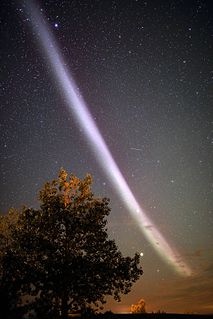 W
WSTEVE is an atmospheric optical phenomenon that appears as a purple and green light ribbon in the sky, named in late 2016 by aurora watchers from Alberta, Canada. According to analysis of satellite data from the European Space Agency's Swarm mission, STEVE is caused by a 25 km (16 mi) wide ribbon of hot plasma at an altitude of 450 km (280 mi), with a temperature of 3,000 °C and flowing at a speed of 6 km/s (3.7 mi/s). The phenomenon is not rare, but had not previously been investigated. In August 2018, researchers determined that the phenomenon's skyglow was not associated with particle precipitation and, as a result, could be generated in the ionosphere.
 W
WThe Sun is the star at the center of the Solar System. It is a nearly perfect sphere of hot plasma, heated to incandescence by nuclear fusion reactions in its core, radiating the energy mainly as visible light and infrared radiation. It is by far the most important source of energy for life on Earth. Its diameter is about 1.39 million kilometres, or 109 times that of Earth. Its mass is about 330,000 times that of Earth, and accounts for about 99.86% of the total mass of the Solar System. Roughly three quarters of the Sun's mass consists of hydrogen (~73%); the rest is mostly helium (~25%), with much smaller quantities of heavier elements, including oxygen, carbon, neon, and iron.
 W
WSunlight is a portion of the electromagnetic radiation given off by the Sun, in particular infrared, visible, and ultraviolet light. On Earth, sunlight is scattered and filtered through Earth's atmosphere, and is obvious as daylight when the Sun is above the horizon. When direct solar radiation is not blocked by clouds, it is experienced as sunshine, a combination of bright light and radiant heat. When blocked by clouds or reflected off other objects, sunlight is diffused. Sources indicate an "Average over the entire earth" of "164 Watts per square meter over a 24 hour day".
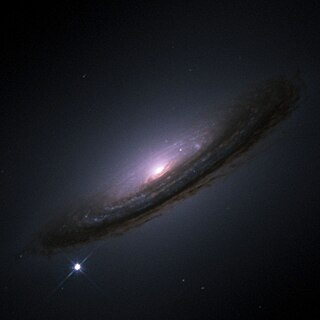 W
WA supernova is a powerful and luminous stellar explosion. This transient astronomical event occurs during the last evolutionary stages of a massive star or when a white dwarf is triggered into runaway nuclear fusion. The original object, called the progenitor, either collapses to a neutron star or black hole, or is completely destroyed. The peak optical luminosity of a supernova can be comparable to that of an entire galaxy before fading over several weeks or months.
 W
WThis is a list of observed supernova remnants (SNRs) in the Milky Way, as well as galaxies nearby enough to resolve individual nebulae, such as the Large and Small Magellanic Clouds and the Andromeda Galaxy.
 W
WA Swedish torch is a source of heat and light from a vertically set tree trunk, incised and burning in the middle. It became known in Europe during the 1600s and is now used by forest workers, and for leisure activities. Due to its flat surface and good embers, it can also be used for cooking. Compared to a campfire, it is more compact, and therefore several small heat sources can be distributed over an area.
 W
WA synchrotron light source is a source of electromagnetic radiation (EM) usually produced by a storage ring, for scientific and technical purposes. First observed in synchrotrons, synchrotron light is now produced by storage rings and other specialized particle accelerators, typically accelerating electrons. Once the high-energy electron beam has been generated, it is directed into auxiliary components such as bending magnets and insertion devices in storage rings and free electron lasers. These supply the strong magnetic fields perpendicular to the beam which are needed to convert high energy electrons into photons.
 W
WTriboluminescence is an optical phenomenon in which light is generated when a material is mechanically pulled apart, ripped, scratched, crushed, or rubbed. The phenomenon is not fully understood, but appears to be caused by the separation and reunification of static electrical charges. The term comes from the Greek τρίβειν and the Latin lumen (light). Triboluminescence can be observed when breaking sugar crystals and peeling adhesive tapes.
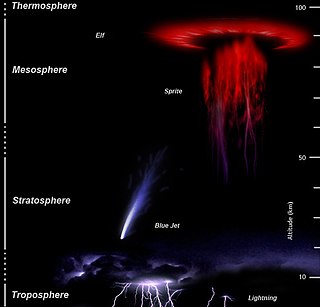 W
WUpper-atmospheric lightning or ionospheric lightning are terms sometimes used by researchers to refer to a family of short-lived electrical-breakdown phenomena that occur well above the altitudes of normal lightning and storm clouds. Upper-atmospheric lightning is believed to be electrically induced forms of luminous plasma. The preferred usage is transient luminous event (TLE), because the various types of electrical-discharge phenomena in the upper atmosphere lack several characteristics of the more familiar tropospheric lightning.
 W
WThe zodiacal light is a faint, diffuse, and roughly triangular white glow that is visible in the night sky and appears to extend from the Sun's direction and along the zodiac, straddling the ecliptic. Sunlight scattered by interplanetary dust causes this phenomenon. Zodiacal light is best seen during twilight after sunset in spring and before sunrise in autumn, when the zodiac is at a steep angle to the horizon. However, the glow is so faint that moonlight and/or light pollution outshine it, rendering it invisible.